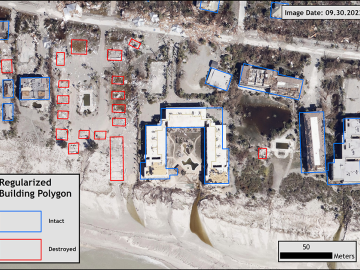
Filter News
Area of Research
- (-) National Security (32)
- (-) Supercomputing (136)
- Advanced Manufacturing (6)
- Biology and Environment (68)
- Biology and Soft Matter (1)
- Building Technologies (2)
- Computational Biology (1)
- Computational Engineering (3)
- Computer Science (16)
- Electricity and Smart Grid (1)
- Energy Science (113)
- Energy Sciences (1)
- Functional Materials for Energy (1)
- Fusion and Fission (12)
- Fusion Energy (2)
- Isotopes (1)
- Materials (90)
- Materials for Computing (18)
- Mathematics (1)
- Neutron Science (22)
- Nuclear Science and Technology (3)
- Quantum information Science (8)
News Topics
- (-) Artificial Intelligence (46)
- (-) Chemical Sciences (5)
- (-) Computer Science (105)
- (-) Frontier (32)
- (-) Machine Learning (24)
- (-) Microscopy (7)
- (-) Polymers (2)
- 3-D Printing/Advanced Manufacturing (7)
- Advanced Reactors (2)
- Big Data (25)
- Bioenergy (11)
- Biology (14)
- Biomedical (17)
- Biotechnology (3)
- Buildings (4)
- Coronavirus (16)
- Critical Materials (3)
- Cybersecurity (23)
- Energy Storage (9)
- Environment (26)
- Exascale Computing (26)
- Fusion (2)
- Grid (11)
- High-Performance Computing (45)
- Isotopes (2)
- Materials (16)
- Materials Science (17)
- Mathematics (2)
- Molten Salt (1)
- Nanotechnology (11)
- National Security (36)
- Neutron Science (15)
- Nuclear Energy (8)
- Partnerships (5)
- Physics (9)
- Quantum Computing (20)
- Quantum Science (26)
- Security (15)
- Simulation (16)
- Software (1)
- Space Exploration (3)
- Summit (43)
- Transportation (8)
Media Contacts

Environmental scientists at ORNL have recently expanded collaborations with minority-serving institutions and historically Black colleges and universities across the nation to broaden the experiences and skills of student scientists while bringing fresh insights to the national lab’s missions.

A study by Oak Ridge National Laboratory researchers has demonstrated how satellites could enable more efficient, secure quantum networks.

U2opia Technology, a consortium of technology and administrative executives with extensive experience in both industry and defense, has exclusively licensed two technologies from ORNL that offer a new method for advanced cybersecurity monitoring in real time.

Critical Materials Institute researchers at Oak Ridge National Laboratory and Arizona State University studied the mineral monazite, an important source of rare-earth elements, to enhance methods of recovering critical materials for energy, defense and manufacturing applications.

ORNL’s next major computing achievement could open a new universe of scientific possibilities accelerated by the primal forces at the heart of matter and energy.

Having lived on three continents spanning the world’s four hemispheres, Philipe Ambrozio Dias understands the difficulties of moving to a new place.

Laboratory Director Thomas Zacharia presented five Director’s Awards during Saturday night's annual Awards Night event hosted by UT-Battelle, which manages ORNL for the Department of Energy.

Over the past seven years, researchers in ORNL’s Geospatial Science and Human Security Division have mapped and characterized all structures within the United States and its territories to aid FEMA in its response to disasters. This dataset provides a consistent, nationwide accounting of the buildings where people reside and work.

ORNL researchers are deploying their broad expertise in climate data and modeling to create science-based mitigation strategies for cities stressed by climate change as part of two U.S. Department of Energy Urban Integrated Field Laboratory projects.

Two years after ORNL provided a model of nearly every building in America, commercial partners are using the tool for tasks ranging from designing energy-efficient buildings and cities to linking energy efficiency to real estate value and risk.


